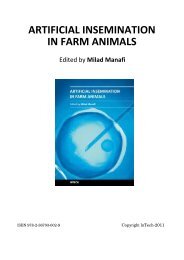The Discovery of Egg and Sperm in the 17th Century - Phenix-Vet
The Discovery of Egg and Sperm in the 17th Century - Phenix-Vet
The Discovery of Egg and Sperm in the 17th Century - Phenix-Vet
You also want an ePaper? Increase the reach of your titles
YUMPU automatically turns print PDFs into web optimized ePapers that Google loves.
6 M Cobbs<strong>in</strong>gle, enormous egg which was apparently passive, while<strong>the</strong> ‘spermatic animals’ were microscopic, <strong>in</strong>crediblyactive <strong>and</strong> present <strong>in</strong> m<strong>in</strong>d-boggl<strong>in</strong>g numbers. Ultimately,however, <strong>the</strong> reason why late <strong>17th</strong>-century th<strong>in</strong>kers didnot realize what to us seems bl<strong>in</strong>d<strong>in</strong>gly obvious – that bo<strong>the</strong>gg <strong>and</strong> sperm make equal contributions to <strong>the</strong> future<strong>of</strong>fspr<strong>in</strong>g – was that <strong>the</strong>re was no compell<strong>in</strong>g evidence tomake <strong>the</strong>m appreciate this.It was not until <strong>the</strong> 19th century that <strong>the</strong> requisitecomb<strong>in</strong>ation <strong>of</strong> evidence <strong>and</strong> <strong>the</strong>ory came toge<strong>the</strong>r. Tounderst<strong>and</strong> <strong>the</strong> complementary nature <strong>of</strong> egg <strong>and</strong> sperm,scientists needed to have a <strong>the</strong>ory that could expla<strong>in</strong> thatcomplementarity. This came <strong>in</strong> two forms <strong>in</strong> <strong>the</strong> earlydecades <strong>of</strong> <strong>the</strong> 19th century (Cobb 2006b). <strong>The</strong> development<strong>of</strong> ‘cell <strong>the</strong>ory’ by Schleiden <strong>and</strong> Schwann gavean explanation for why egg <strong>and</strong> sperm were equivalent,despite <strong>the</strong>ir manifold differences – <strong>the</strong>y were bothreproductive cells. <strong>The</strong> o<strong>the</strong>r factor was that realizationthat heredity had a biological content <strong>and</strong> that someth<strong>in</strong>gwas <strong>in</strong>herited, which was conta<strong>in</strong>ed <strong>in</strong> egg <strong>and</strong>sperm, respectively. This development came aboutthrough <strong>the</strong> conjunction <strong>of</strong> three areas: <strong>the</strong> work <strong>of</strong>agro-<strong>in</strong>dustrialists such as Robert Bakewell, who carriedout massive selective breed<strong>in</strong>g programmes on domesticatedanimals; <strong>the</strong> studies by th<strong>in</strong>kers such as Maupertuis<strong>and</strong> Re´aumur, who explored large <strong>and</strong> complexfamily trees <strong>in</strong> <strong>the</strong> light <strong>of</strong> particular characters; <strong>and</strong> byFrench physicians who studied <strong>the</strong> <strong>in</strong>heritance <strong>of</strong>diseases (Cobb 2006b). This was f<strong>in</strong>ally given form <strong>in</strong>a monastery <strong>in</strong> Brno, where Gregor Mendel was just one<strong>of</strong> many people th<strong>in</strong>k<strong>in</strong>g about <strong>the</strong> nature <strong>of</strong> heredity.Oddly enough, by <strong>the</strong> time that <strong>the</strong> fusion <strong>of</strong> egg <strong>and</strong>sperm was observed for <strong>the</strong> first time, by Hertwig <strong>and</strong>Fol <strong>in</strong> <strong>the</strong> late 1870s, it was almost an anti-climax.People thought it was obvious. Which <strong>in</strong> a way, it was,but gett<strong>in</strong>g to such a po<strong>in</strong>t had been anyth<strong>in</strong>g butstraightforward, <strong>and</strong> would not have occurred withoutthat excit<strong>in</strong>g spasm <strong>of</strong> discovery <strong>in</strong> <strong>the</strong> <strong>17th</strong> century.Conflicts <strong>of</strong> <strong>in</strong>terestNone <strong>of</strong> <strong>the</strong> authors have any conflicts <strong>of</strong> <strong>in</strong>terest to declare.ReferencesAnonymous, 1679: Gaspari Barthol<strong>in</strong>i Th.Filii De Ovariis mulierum & generationishistoria Epistola Anatomica. Journal desScavans , 63–64.Birch T, 1756–7: <strong>The</strong> History <strong>of</strong> <strong>the</strong> RoyalSociety <strong>of</strong> London for Improv<strong>in</strong>g <strong>of</strong>Natural Knowledge. Millar, London.Cobb M, 2006a: <strong>The</strong> <strong>Egg</strong> <strong>and</strong> <strong>Sperm</strong> Race:<strong>The</strong> Seventeenth <strong>Century</strong> Scientists WhoUnravelled <strong>the</strong> Secrets <strong>of</strong> Life, Sex <strong>and</strong>Growth. Free Press, London.Cobb M, 2006b: Heredity before genetics: ahistory. Nat Rev Genet 7, 953–958.Cole FJ, 1930: Early <strong>The</strong>ories <strong>of</strong> SexualGeneration. Clarendon, Oxford.De Graaf R, 1668: De Vivorum OrganisGenerationi <strong>in</strong>servientibus de Clysteribuset de usu Siphonis <strong>in</strong> Anatomia. Hack, Leiden.De Graaf R, 1671: Epistola ad virum clarissimumD. Lucam Schacht. In: de GraafR (ed.), Tractatus Anatomico-Mdeicus deSucci Pancreatici Natura & Usu. Hak,Leiden, pp. 209–216.De Graaf R, 1672: De Mulierum OrganisGenerationi Inservientibus. Hack, Leiden.De Graaf R, 1673a: Partium GenitaliumDefensio. Hack, Leiden.De Graaf R, 1673b: Letter to Oldenburg (18April 1673). In: Hall AR, Hall M (eds),1973: <strong>The</strong> Correspondence <strong>of</strong> Henry Oldenburgvol 9. University <strong>of</strong> Wiscons<strong>in</strong>Press, Madison, pp. 603.DobellC,1932:AntonyvanLeeuwenhoek<strong>and</strong>his ‘‘Little Animals’’. Constable, London.Ford BJ, 1985: S<strong>in</strong>gle Lens: <strong>The</strong> Story <strong>of</strong> <strong>the</strong>Simple Microscope. Harper & Row,New York.Furth C, 1999: A Flourish<strong>in</strong>g Y<strong>in</strong>: Gender <strong>in</strong>Ch<strong>in</strong>a’s Medical History, 960–1665. CaliforniaUniversity Press, Berkeley.Hall MB, 2002: Henry Oldenburg: Shap<strong>in</strong>g<strong>the</strong> Royal Society. Oxford UniversityPress, Oxford.Harvey W, 1651: Exercitationes de GenerationeAnimalium. Jansson, Amsterdam.Huygens C, 1678: Extrait d’une lettre de M.Huygens de l’Académiie R. des Sciences àl’auteur du journal, touchant une nouvellemanière de microscope qu’il a apporté deHoll<strong>and</strong>e. Journal des Sçavans, 331–332.Jocelyn HD, Setchell BP, 1972: Regnier deGraaf on <strong>the</strong> human reproductive organs.J Reprod Fertil Suppl 17, 1–222.Leeuwenhoek A, 1678: Observationes D.Anthonii Lewenhoeck, de natis è sem<strong>in</strong>igenitali animalcules. Phil Trans R SocLond B 12, 1040–1043.Leeuwenhoek A, 1683: An abstract <strong>of</strong> aLetter from Mr. Anthony Leewenhoeckwrit to Sir C.W. Jan. 22. 1682 ⁄ 3 fromDelft. Phil Trans R Soc Lond B 13, 74–81.Leewenhoecks (sic), 1677: Monsieur Leewenheocksletter to <strong>the</strong> publishere, where<strong>in</strong>some account is given <strong>of</strong> <strong>the</strong> manner <strong>of</strong>his observ<strong>in</strong>g so great a number <strong>of</strong> littleanimals <strong>in</strong> divers sorts <strong>of</strong> water, as wasdeliver’d <strong>in</strong> <strong>the</strong> next forego<strong>in</strong>g Tract:English’d out <strong>of</strong> Dutch. Phil Trans RSoc Lond B 12, 844–846.L<strong>in</strong>deboom GA (ed.), 1975: <strong>The</strong> Letters <strong>of</strong>Jan Swammerdam to Melchisedec Thévenot.Swets & Zeitl<strong>in</strong>ger, Amsterdam.Luyendijk-Elshout AM, 1965: Introduction.In: Ruysch F Dilucidatio Valvorum <strong>in</strong>Vasis Lymphasticis et Lacteis (Facsimile).De Graaf Nieuwkoop, <strong>The</strong> Ne<strong>the</strong>rl<strong>and</strong>s,pp. 7–49.P<strong>in</strong>to-Correia C, 1997: <strong>The</strong> Ovary <strong>of</strong> Eve:<strong>Egg</strong> <strong>and</strong> <strong>Sperm</strong> <strong>and</strong> Preformation. University<strong>of</strong> Chicago Press, London.Potts M, Short R, 1999: Ever S<strong>in</strong>ce Adam<strong>and</strong> Eve: <strong>The</strong> Evolution <strong>of</strong> Human Sexuality.Cambridge University Press,Cambridge.Redi F, 1668: Esperienze Intorno alla GenerazioneDegl’<strong>in</strong>setti. Stella, Florence.Roger J, 1997: <strong>The</strong> Life Sciences <strong>in</strong> Eighteenth-<strong>Century</strong>French Thought. StanfordUniversity Press, Stanford.Ruestow EG, 1995: <strong>The</strong> Microscope <strong>in</strong> <strong>the</strong>Dutch Republic. Cambridge UniversityPress, Cambridge.Short RV, 1977: <strong>The</strong> discovery <strong>of</strong> <strong>the</strong> ovaries.In: Zuckerman S, Weir BJ (eds), <strong>The</strong>Ovary, Volume 1: General Aspects. AcademicPress, New York, pp. 1–39.Short RV, 1978: Harvey’s conception: ‘Degeneratione animalium’, 1651. In: Dick<strong>in</strong>sonCJ, Marks J (eds), Developments <strong>in</strong>Cardiovascular Medic<strong>in</strong>e. MTP, Lancaster,pp. 353–363.Steno N, 1668: Elementorum MyologiaeSpecimen. Stella, Florence.Swammerdam J, 1669: Historia InsectorumGeneralis, <strong>of</strong>te Algemeene Verh<strong>and</strong>el<strong>in</strong>gvan de Bloedeloose Dierkens. Van Dreunen,Utrech.Swammerdam J, 1672a: Miraculum Naturae,sive Uteri Muliebris Fabrica. Sever<strong>in</strong>usMat<strong>the</strong>i, Lieden.Swammerdam J, n.d. 1672b: Exquisita Demonstratio.Vasorum <strong>Sperm</strong>aticorum,Testium sive Ovarii, Tubarum seuCornuum, &c. n.p., n.p.<strong>The</strong>´venotM,1665:LettertoHuygens(24April1665). In: Huygens C (ed.), 1977: OeuvresComplètes de Christiaan Huygens vol 5.Swets Zeitl<strong>in</strong>ger, Amsterdam, pp. 343.Tomal<strong>in</strong> C, 2002: Samuel Pepys: <strong>The</strong> UnequalledSelf. Pengu<strong>in</strong>, London.Van Horne J, 1668: Observationum suarumCirca Partes Generationis <strong>in</strong> UtroqueSexu Prodromus. Gaasbekios, Leiden.Von Baer KE, 1956: On <strong>the</strong> genesis <strong>of</strong> <strong>the</strong>ovum <strong>of</strong> mammals <strong>and</strong> <strong>of</strong> man. Isis47, 117–153.Wilson C, 1995: <strong>The</strong> Invisible World. Pr<strong>in</strong>cetonUniversity Press, Pr<strong>in</strong>ceton.Author’s address (for correspondence):M Cobb, Faculty <strong>of</strong> Life Sciences, University<strong>of</strong> Manchester, Oxford Road, ManchesterM13 9PT, UK. E-mail: cobb@manchester.ac.ukÓ 2012 Blackwell Verlag GmbH










